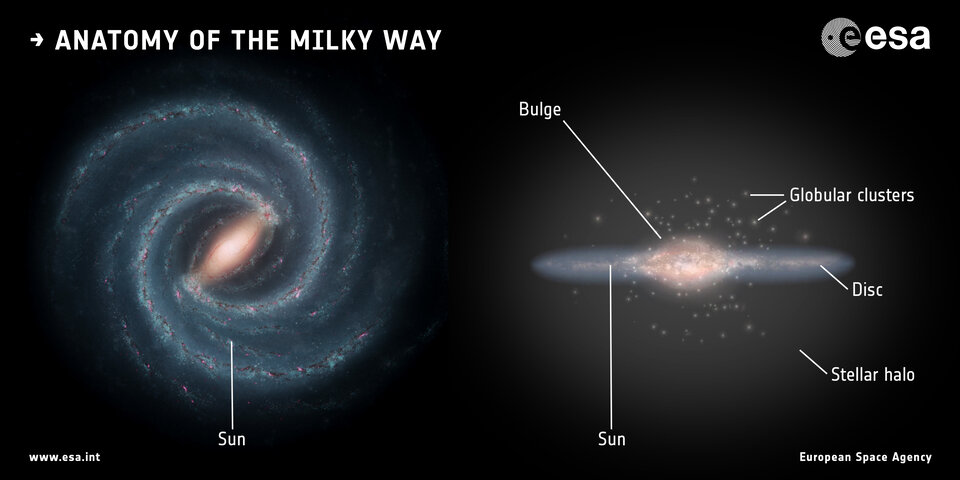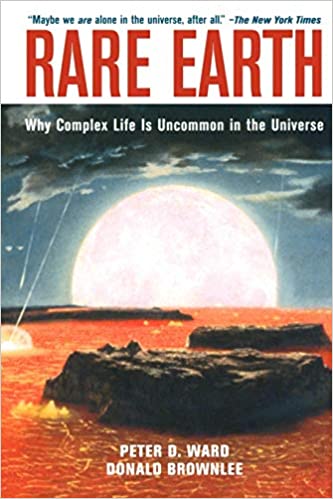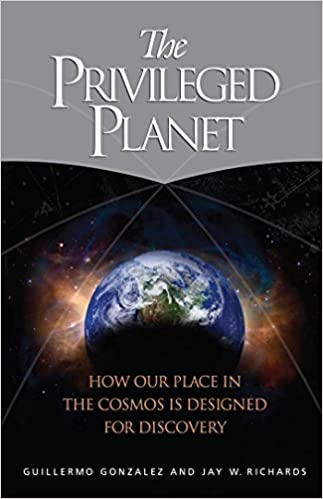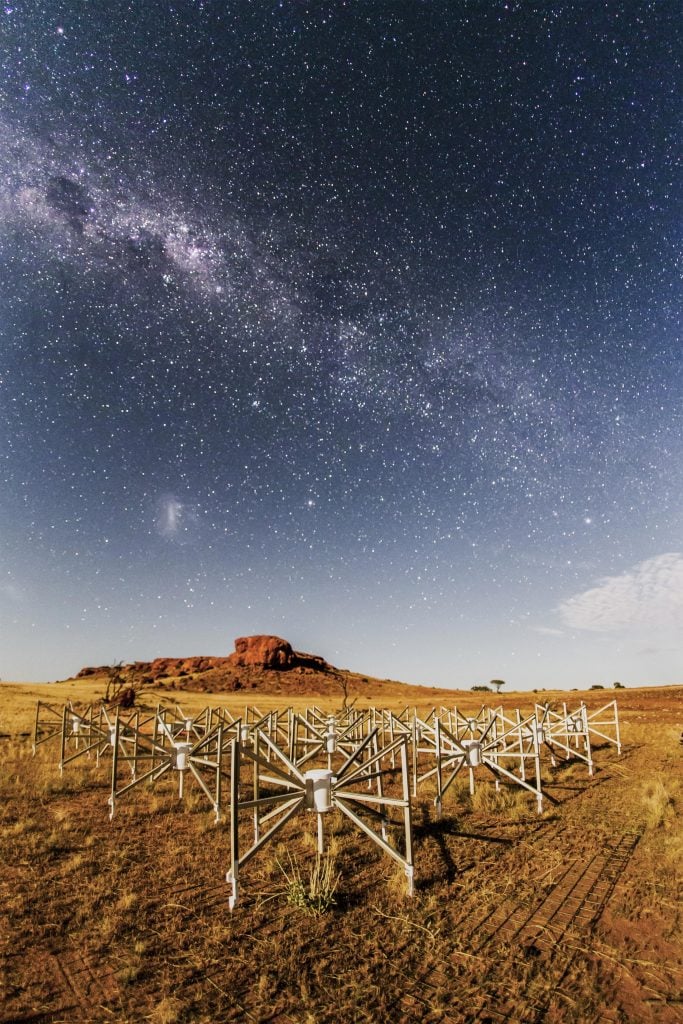Posted for fair use.....
For linked videos please see article source.....
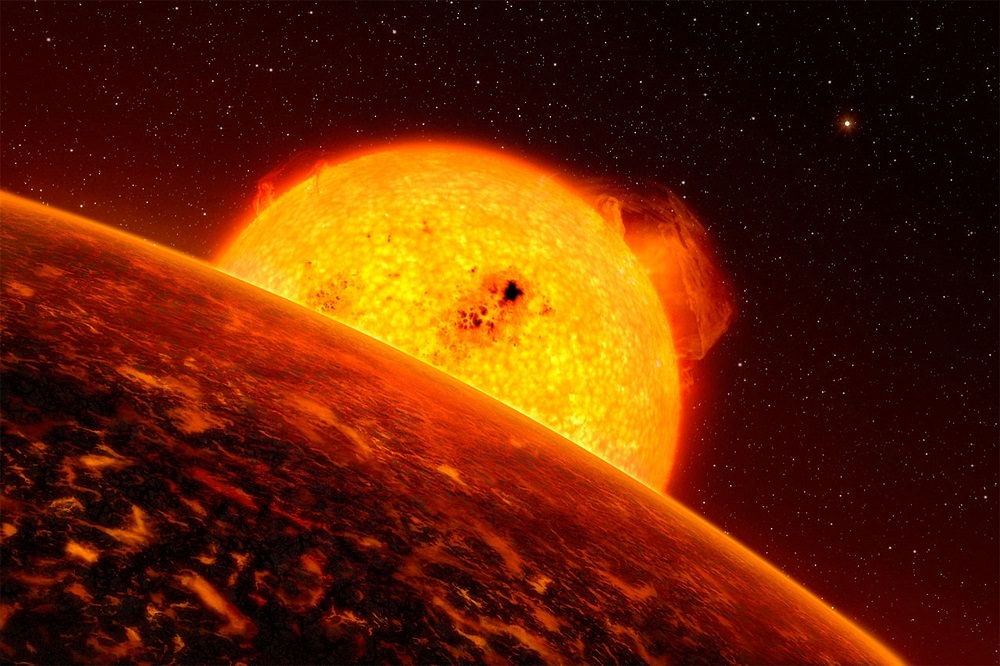
 www.universetoday.com
www.universetoday.com
Universe Today
Space and astronomy news

Posted on September 27, 2020 by Matt Williams
Beyond “Fermi’s Paradox” X: What is the Firstborn Hypothesis?
Welcome back to our Fermi Paradox series, where we take a look at possible resolutions to Enrico Fermi’s famous question, “Where Is Everybody?” Today, we examine the possibility that the reason for the Great Silence is that we are “early to the party”!
In 1950, Italian-American physicist Enrico Fermi sat down to lunch with some of his colleagues at the Los Alamos National Laboratory, where he had worked five years prior as part of the Manhattan Project. According to various accounts, the conversation turned to aliens and the recent spate of UFOs. Into this, Fermi issued a statement that would go down in the annals of history: “Where is everybody?“
This became the basis of the Fermi Paradox, which refers to the disparity between high probability estimates for the existence of extraterrestrial intelligence (ETI) and the apparent lack of evidence. Since Fermi’s time, there have been several proposed resolutions to his question, which includes the Firstborn Hypothesis that states that humanity could be the first intelligent life to emerge in our galaxy.
The Firstborn Hypothesis is similar in some respects to the Hart-Tipler Conjecture and other schools of thought that attribute the “Great Silence” to the fact that humanity is the only advanced species in the known Universe. However, rather than assuming that intelligent life (or life in general) is non-existent, the Firstborn Hypothesis emphasizes that complex life (in all of its forms) has been rare until recently.
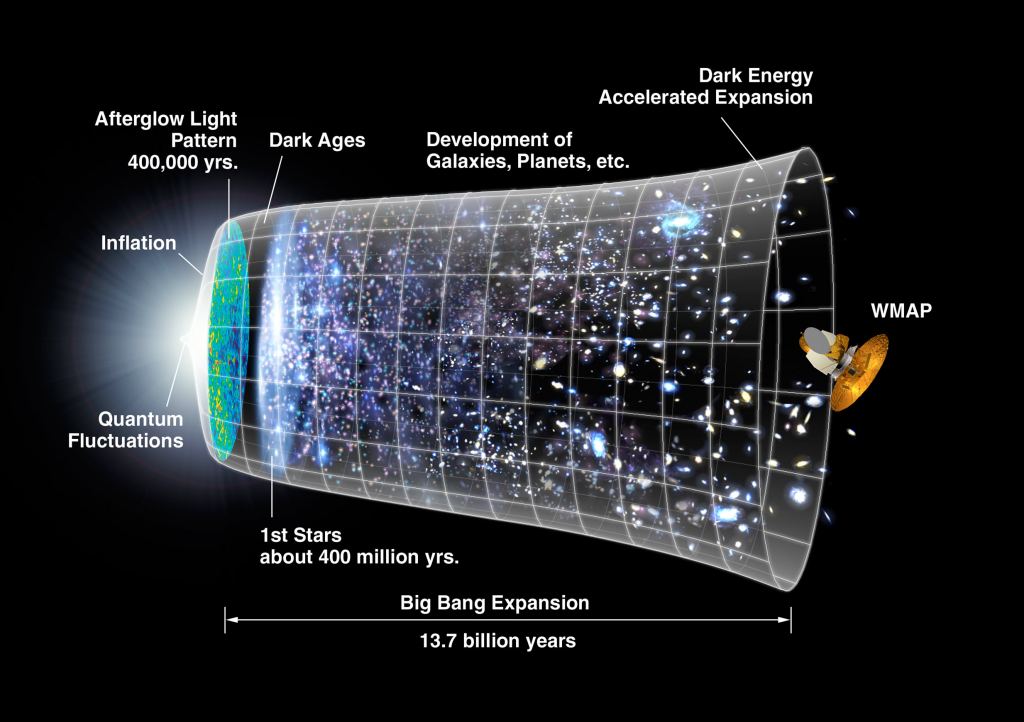 Timeline of the Big Bang and the expansion of the Universe. Credit: NASA A Long Time Running
Timeline of the Big Bang and the expansion of the Universe. Credit: NASA A Long Time Running
One of the main assumptions behind the Fermi Paradox is that life has had innumerable chances to emerge in our Universe. On the one hand, there is the abundance of space in our galaxy alone, which measures about 200,000 light-years in diameter, contains anywhere from 100 to 400 billion stars, and has an estimated 60 billion planets orbiting within their star’s habitable zone (HZ), 6 billion of which are “Earth-like.”
But then there’s the other all-important dimension, which is time. The Universe has been an estimated 13.8 billion years, the first galaxies existed by 13 billion years ago, and planets began to form shortly thereafter. Considering that our Solar System has only been around for the past 4.6 billion years or so, one would think that life in the Universe has a pretty big head start on Earth-based life forms.
But what if it didn’t? What if we are currently living in a cosmological window where the emergence of life is possible, and in previous epochs, conditions were too harsh for life to exist? Arguments of this nature have been made by many researchers attempting to resolve the Fermi Paradox. In each case, they began with the hypothesis that extraterrestrial life hasn’t had enough time to catch up with us, let alone overtake us.
Anthropic Principle
A key concept that informs this hypothesis is the Anthropic Principle, which is essentially the opposite of the Cosmological Principle (aka. Copernican Principle or “principle of mediocrity”). Whereas the latter assumes that life is typical within the cosmos, which means humanity is not in a unique and special position, the Anthropic Principle states that observations made of the Universe are entirely dependent on its laws being conducive to life.
The phrase itself was coined by theoretical astrophysicist Brandon Carter, who presented the idea during a 1973 symposium in Krakow, Poland, in honor of Copernicus’s 500th birthday. Here, he articulated the principle in response to the Copernican Principle, saying, “Although our situation is not necessarily central, it is inevitably privileged to some extent.”
Specifically, Carter challenged the way the Copernican Principle was being used to justify the idea that all large regions in the Universe (in both space and time) were statistically identical. This notion was central to the Steady State Hypothesis, which had recently been debunked with the discovery of the Cosmic Microwave Background (CMB) radiation. As David Brin would later describe it in the context of the Fermi debate:
Origin
While it is difficult to pinpoint the exact source of the Firstborn Hypothesis, many studies have been conducted throughout the years that have hinted at this premise. A solid example is the 1982 study by Lawrence Bracewell – a Professor with the Space, Telecommunications, and Radioscience Laboratory (STAR Lab) at Stanford University – titled “Preemption of the Galaxy by the first advanced civilization.”
In it, Bracewell considered how the first civilizations to emerge in an environment can invariably hold back those that follow. This theory was applied in support of his argument that humanity may be the first advanced civilization to emerge in our galaxy, hence why we haven’t heard from any others. As he summarized:
Those Deadly GRBs!
James Annis of the Fermi National Accelerator Lab argued something similar in a 1999 study titled “An Astrophysical Explanation for the Great Silence.” According to Annis, periodic gamma-ray bursts (GRBs) could be responsible for limiting the emergence of intelligent life, since they occur at periodic intervals and are powerful enough to cause mass extinctions.
These bursts are the most energetic phenomena in the Universe and occur when massive stars go supernova. The bursts are usually brief (but can be long-lived in the event of a binary companion), emerge from the star’s axis of rotation (aka. polar regions), and be lethal to any planets that lie along their path. In fact, recent research indicates that a GRB may have been responsible for the Ordovician Extinction (ca. 440 million years ago).
Annis employed then-current astrophysical models that suggest that the mean time between GRBs is on the order of 1 billion years. Similarly, evolutionary models used by Annis indicate that this is the same amount of time it takes for intelligence to emerge. This is consistent with the interval between the existence of multi-cellular life and high-order primates (which includes modern humans). As he summarized:
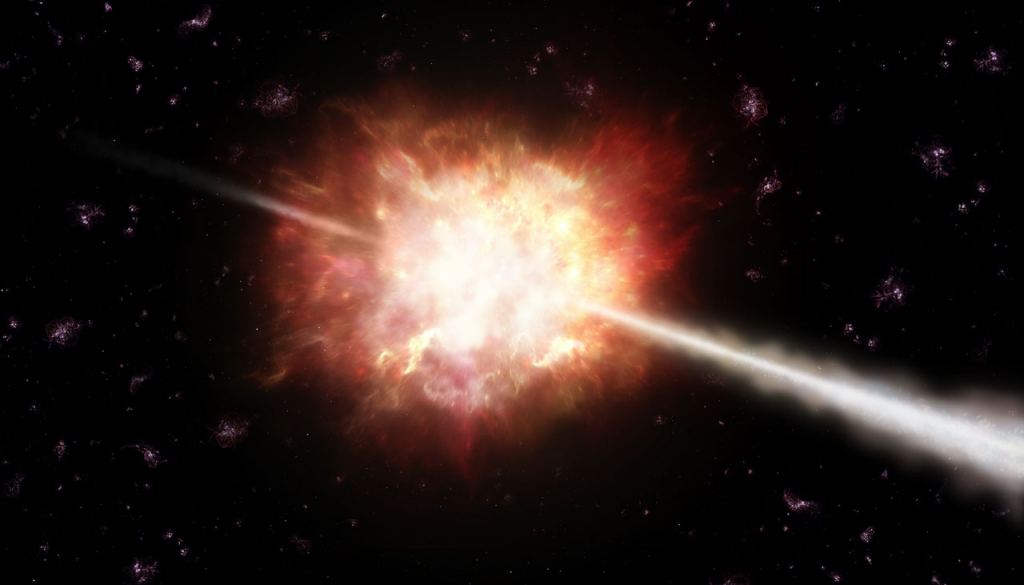 Gamma-ray bursts (GRBs) are powerful flashes of energetic gamma-rays lasting from less than a second to several minutes. Credit: ESO/A. Roquette
Gamma-ray bursts (GRBs) are powerful flashes of energetic gamma-rays lasting from less than a second to several minutes. Credit: ESO/A. Roquette
In 2008, astronomers Milan M. Cirkovic and Branislav Vukotic of the Astronomical Observatory of Belgrade build upon this argument with a study titled “Astrobiological Phase Transition: Towards Resolution of Fermi’s Paradox.” For their study, Cirkovic and Branislav created a model to test whether or not gamma-ray bursts and other astrobiological regulating mechanisms can periodically “reset” the cosmological clock.
Continued.....
For linked videos please see article source.....

Beyond “Fermi’s Paradox” X: What is the Firstborn Hypothesis?
In this latest instalment, we explore the possibility that humanity is an early arrival to the Universe, and that intelligent species will become more common with time.
 www.universetoday.com
www.universetoday.com
Universe Today
Space and astronomy news

Posted on September 27, 2020 by Matt Williams
Beyond “Fermi’s Paradox” X: What is the Firstborn Hypothesis?
Welcome back to our Fermi Paradox series, where we take a look at possible resolutions to Enrico Fermi’s famous question, “Where Is Everybody?” Today, we examine the possibility that the reason for the Great Silence is that we are “early to the party”!
In 1950, Italian-American physicist Enrico Fermi sat down to lunch with some of his colleagues at the Los Alamos National Laboratory, where he had worked five years prior as part of the Manhattan Project. According to various accounts, the conversation turned to aliens and the recent spate of UFOs. Into this, Fermi issued a statement that would go down in the annals of history: “Where is everybody?“
This became the basis of the Fermi Paradox, which refers to the disparity between high probability estimates for the existence of extraterrestrial intelligence (ETI) and the apparent lack of evidence. Since Fermi’s time, there have been several proposed resolutions to his question, which includes the Firstborn Hypothesis that states that humanity could be the first intelligent life to emerge in our galaxy.
The Firstborn Hypothesis is similar in some respects to the Hart-Tipler Conjecture and other schools of thought that attribute the “Great Silence” to the fact that humanity is the only advanced species in the known Universe. However, rather than assuming that intelligent life (or life in general) is non-existent, the Firstborn Hypothesis emphasizes that complex life (in all of its forms) has been rare until recently.

One of the main assumptions behind the Fermi Paradox is that life has had innumerable chances to emerge in our Universe. On the one hand, there is the abundance of space in our galaxy alone, which measures about 200,000 light-years in diameter, contains anywhere from 100 to 400 billion stars, and has an estimated 60 billion planets orbiting within their star’s habitable zone (HZ), 6 billion of which are “Earth-like.”
But then there’s the other all-important dimension, which is time. The Universe has been an estimated 13.8 billion years, the first galaxies existed by 13 billion years ago, and planets began to form shortly thereafter. Considering that our Solar System has only been around for the past 4.6 billion years or so, one would think that life in the Universe has a pretty big head start on Earth-based life forms.
But what if it didn’t? What if we are currently living in a cosmological window where the emergence of life is possible, and in previous epochs, conditions were too harsh for life to exist? Arguments of this nature have been made by many researchers attempting to resolve the Fermi Paradox. In each case, they began with the hypothesis that extraterrestrial life hasn’t had enough time to catch up with us, let alone overtake us.
Anthropic Principle
A key concept that informs this hypothesis is the Anthropic Principle, which is essentially the opposite of the Cosmological Principle (aka. Copernican Principle or “principle of mediocrity”). Whereas the latter assumes that life is typical within the cosmos, which means humanity is not in a unique and special position, the Anthropic Principle states that observations made of the Universe are entirely dependent on its laws being conducive to life.
The phrase itself was coined by theoretical astrophysicist Brandon Carter, who presented the idea during a 1973 symposium in Krakow, Poland, in honor of Copernicus’s 500th birthday. Here, he articulated the principle in response to the Copernican Principle, saying, “Although our situation is not necessarily central, it is inevitably privileged to some extent.”
Specifically, Carter challenged the way the Copernican Principle was being used to justify the idea that all large regions in the Universe (in both space and time) were statistically identical. This notion was central to the Steady State Hypothesis, which had recently been debunked with the discovery of the Cosmic Microwave Background (CMB) radiation. As David Brin would later describe it in the context of the Fermi debate:
This principle is central to arguments that assert that humanity is alone in the Universe (or is the first intelligent species to arise in the Milky Way). Basically, it assumes that the Universe exists in a state of disequilibrium, where things have gone from being hostile to conducive to life. Humanity is therefore alive during a transitional phase in the Universe that will be followed by the emergence of many intelligent species.“The philosophical counter to the principle of mediocrity is the ‘Anthropic Principle,’ which proposes that it is possible, even in a great and diverse Universe, for an observer to witness a special place and time, especially if the special attribute is required for there to be an observer in the first place… Uniqueness advocates see nothing wrong with the proposal that the intelligent life we see on Earth is rare.”
Origin
While it is difficult to pinpoint the exact source of the Firstborn Hypothesis, many studies have been conducted throughout the years that have hinted at this premise. A solid example is the 1982 study by Lawrence Bracewell – a Professor with the Space, Telecommunications, and Radioscience Laboratory (STAR Lab) at Stanford University – titled “Preemption of the Galaxy by the first advanced civilization.”
In it, Bracewell considered how the first civilizations to emerge in an environment can invariably hold back those that follow. This theory was applied in support of his argument that humanity may be the first advanced civilization to emerge in our galaxy, hence why we haven’t heard from any others. As he summarized:
If this is true, humanity may want to examine its “planetary protection” protocols and update them. In this case, rather than avoiding areas thought to have microbial life or sterilizing robotic missions to prevent contamination, perhaps we should take a page from the “Zoo Hypothesis” and create quarantine zones around inhabited planets to ensure we don’t interfere with the development of life on them.“[T]errestrial history demonstrates that the advent of one tool-capable and traveling population results in that species’ expansion to all viable territories. The spread of the population occurs in much shorter time than does the evolution of the species, indicating that, perhaps, humans are the first intelligent species in the Galaxy, and may be the future population of the Galaxy.”
Those Deadly GRBs!
James Annis of the Fermi National Accelerator Lab argued something similar in a 1999 study titled “An Astrophysical Explanation for the Great Silence.” According to Annis, periodic gamma-ray bursts (GRBs) could be responsible for limiting the emergence of intelligent life, since they occur at periodic intervals and are powerful enough to cause mass extinctions.
These bursts are the most energetic phenomena in the Universe and occur when massive stars go supernova. The bursts are usually brief (but can be long-lived in the event of a binary companion), emerge from the star’s axis of rotation (aka. polar regions), and be lethal to any planets that lie along their path. In fact, recent research indicates that a GRB may have been responsible for the Ordovician Extinction (ca. 440 million years ago).
Annis employed then-current astrophysical models that suggest that the mean time between GRBs is on the order of 1 billion years. Similarly, evolutionary models used by Annis indicate that this is the same amount of time it takes for intelligence to emerge. This is consistent with the interval between the existence of multi-cellular life and high-order primates (which includes modern humans). As he summarized:
“If one assumes that [GRBs] are in fact lethal to land based life throughout the galaxy, one has a mechanism that prevents the rise of intelligence until the mean time between bursts is comparable to the timescale for the evolution of intelligence…
“Hence, this model suggests that the Galaxy is currently undergoing a phase transition between an equilibrium state devoid of intelligent life to a different equilibrium state where it is full of intelligent life.”

In 2008, astronomers Milan M. Cirkovic and Branislav Vukotic of the Astronomical Observatory of Belgrade build upon this argument with a study titled “Astrobiological Phase Transition: Towards Resolution of Fermi’s Paradox.” For their study, Cirkovic and Branislav created a model to test whether or not gamma-ray bursts and other astrobiological regulating mechanisms can periodically “reset” the cosmological clock.
Continued.....


